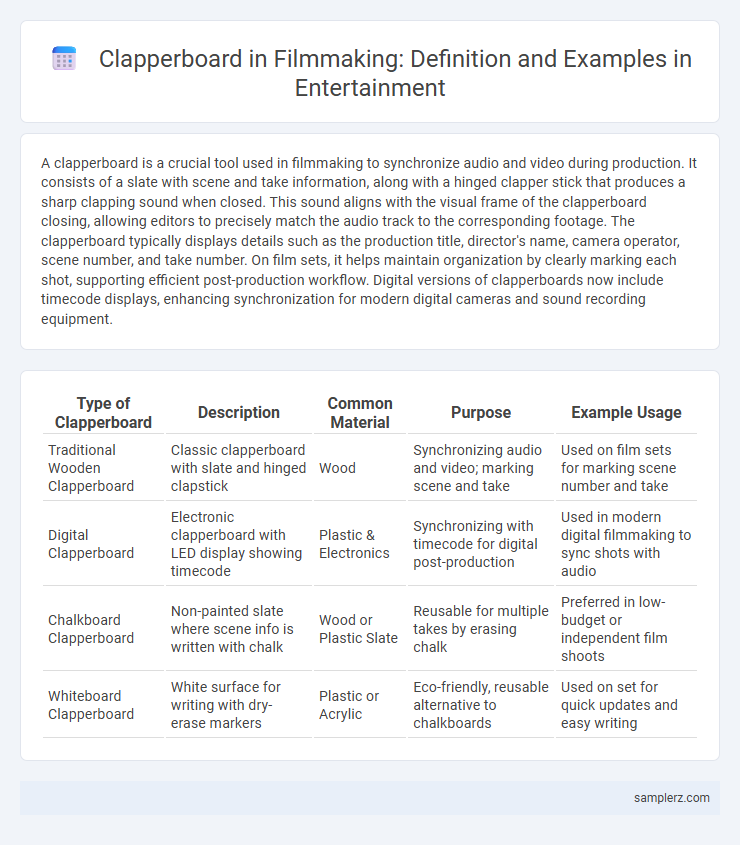A clapperboard is a crucial tool used in filmmaking to synchronize audio and video during production. It consists of a slate with scene and take information, along with a hinged clapper stick that produces a sharp clapping sound when closed. This sound aligns with the visual frame of the clapperboard closing, allowing editors to precisely match the audio track to the corresponding footage. The clapperboard typically displays details such as the production title, director's name, camera operator, scene number, and take number. On film sets, it helps maintain organization by clearly marking each shot, supporting efficient post-production workflow. Digital versions of clapperboards now include timecode displays, enhancing synchronization for modern digital cameras and sound recording equipment.
Table of Comparison
| Type of Clapperboard | Description | Common Material | Purpose | Example Usage |
|---|---|---|---|---|
| Traditional Wooden Clapperboard | Classic clapperboard with slate and hinged clapstick | Wood | Synchronizing audio and video; marking scene and take | Used on film sets for marking scene number and take |
| Digital Clapperboard | Electronic clapperboard with LED display showing timecode | Plastic & Electronics | Synchronizing with timecode for digital post-production | Used in modern digital filmmaking to sync shots with audio |
| Chalkboard Clapperboard | Non-painted slate where scene info is written with chalk | Wood or Plastic Slate | Reusable for multiple takes by erasing chalk | Preferred in low-budget or independent film shoots |
| Whiteboard Clapperboard | White surface for writing with dry-erase markers | Plastic or Acrylic | Eco-friendly, reusable alternative to chalkboards | Used on set for quick updates and easy writing |
Introduction to Clapperboards in Filmmaking
Clapperboards, also known as slate boards, are essential tools in filmmaking used to synchronize audio and video during post-production. They display critical information such as scene number, take number, director's name, and production title, ensuring accurate organization of footage. The iconic clapping sound made by closing the clapper helps editors align sound with the corresponding visual frame for seamless editing.
History and Evolution of the Clapperboard
The clapperboard, first introduced in the early 1920s, revolutionized filmmaking by synchronizing audio and visual components during editing. Initially made of wood with hand-painted slate, it evolved to include acrylic surfaces and digital timecode displays, enhancing precision and durability. Modern clapperboards integrate electronic synchronization technology, reflecting the industry's shift from analog to digital production methods.
Anatomy of a Typical Clapperboard
A typical clapperboard in filmmaking consists of a rectangular slate with a hinged clapper stick at the top, which produces a sharp clapping sound used to synchronize audio and video during post-production. The slate usually displays critical information such as the production title, scene number, take number, director's name, and date, all written in bold, clear lettering for easy visibility on camera. High-quality clapperboards often include white and black stripes on the clapper stick to enhance visibility during filming and may integrate digital timecode displays for precise frame synchronization.
Essential Functions of the Clapperboard
The clapperboard serves essential functions in filmmaking, including synchronizing audio and video by marking the exact frame where the slate closes. It provides critical metadata such as scene, take number, and production details, aiding in organizing footage during post-production. This tool enhances workflow efficiency and ensures accurate syncing for seamless editing processes.
How Clapperboards Synchronize Audio and Video
Clapperboards synchronize audio and video in filmmaking by providing a visual and auditory marker that aligns both tracks during post-production. When the clapper sticks shut, the sharp clapping sound corresponds with the exact frame of the visual clap, enabling editors to match sound waves with the video frame precisely. This synchronization ensures seamless integration of dialogue and action, crucial for maintaining continuity and enhancing the overall quality of the film.
Creative Uses of Clapperboards on Set
Clapperboards serve beyond synchronization in filmmaking by aiding in scene organization and continuity tracking. Creative uses include customizing clapperboards with colorful designs to boost crew morale and using digital clapperboards with integrated timecode for precise editing workflows. Some directors employ clapperboards as interactive tools for scene notes or spontaneous improvisation cues during shoots.
Digital vs. Traditional Clapperboards
Digital clapperboards incorporate LED displays and timecode synchronization, enabling precise scene and take identification while streamlining post-production workflows. Traditional clapperboards rely on manual slate writing and mechanical clapping, offering a tactile and visual reference that remains valuable on set. The evolution from analog to digital clapperboards reflects advancements in filmmaking technology, enhancing accuracy and efficiency in scene organization.
Iconic Examples of Clapperboards in Cinema
The clapperboard used in Stanley Kubrick's "2001: A Space Odyssey" is iconic for its clean, minimalist design that became a symbol of meticulous filmmaking. In Quentin Tarantino's "Pulp Fiction," the clapperboard features handwritten notes capturing the film's dynamic scenes, embodying the director's unique style. The vibrant yellow and black clapperboard from "Jurassic Park" visually represents the thrilling, prehistoric adventure and is remembered for its distinctive look in behind-the-scenes footage.
Tips for Using a Clapperboard Effectively
Using a clapperboard effectively involves clearly writing the scene, take, and production details with bold markers for visibility on camera. Ensure the clap is loud and distinct, capturing both the visual and audio cue to synchronize sound and footage precisely during editing. Position the clapperboard within the camera frame before the slate is snapped to guarantee accurate identification and smooth post-production workflow.
The Symbolic Significance of the Clapperboard in Film Culture
The clapperboard serves as a crucial synchronization tool in filmmaking, marking the start of each take with a distinct visual and auditory cue that ensures precise alignment of sound and image during editing. Beyond its practical function, the clapperboard symbolizes the collaborative and structured nature of film production, embodying the transition from script to on-screen reality. Its iconic presence in behind-the-scenes footage and film sets highlights the intersection of creativity and technical precision central to cinematic storytelling.

example of clapperboard in filmmaking Infographic
 samplerz.com
samplerz.com